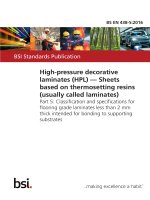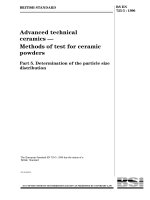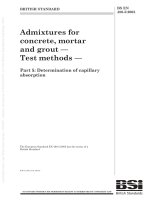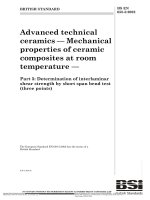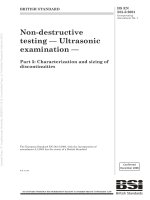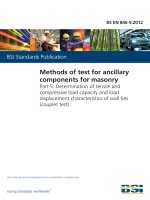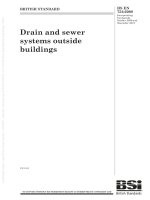Bsi bs en 62037 5 2013
Bạn đang xem bản rút gọn của tài liệu. Xem và tải ngay bản đầy đủ của tài liệu tại đây (1.06 MB, 16 trang )
BS EN 62037-5:2013
BSI Standards Publication
Passive RF and microwave
devices, intermodulation
level measurement
Part 5: Measurement of passive
intermodulation in filters
BRITISH STANDARD
BS EN 62037-5:2013
National foreword
This British Standard is the UK implementation of EN 62037-5:2013.
It is identical to IEC 62037-5:2013. Together with BS EN 62037-1:2012,
BS EN 62037-2:2013, BS EN 62037-3:2012, BS EN 62037-4:2012 and
BS EN 62037-6:2013, it supersedes BS EN 62037:2000, which will be
withdrawn on 15 July 2015.
The UK participation in its preparation was entrusted to Technical Committee
EPL/46, Cables, wires and waveguides, radio frequency connectors and
accessories for communication and signalling.
A list of organizations represented on this committee can be obtained on
request to its secretary.
This publication does not purport to include all the necessary provisions
of a contract. Users are responsible for its correct application.
© The British Standards Institution 2013.
Published by BSI Standards Limited 2013.
ISBN 978 0 580 58421 3
ICS 33.040.20
Compliance with a British Standard cannot confer immunity
from legal obligations.
This British Standard was published under the authority of the
Standards Policy and Strategy Committee on 30 April 2013.
Amendments issued since publication
Date
Text affected
BS EN 62037-5:2013
EN 62037-5
EUROPEAN STANDARD
NORME EUROPÉENNE
EUROPÄISCHE NORM
April 2013
ICS 33.040.20
Supersedes EN 62037:1999 (partially)
English version
Passive RF and microwave devices, intermodulation level measurement Part 5: Measurement of passive intermodulation in filters
(IEC 62037-5:2013)
Dispositifs RF et à micro-ondes passifs,
mesure du niveau d’intermodulation Partie 5: Mesure de l’intermodulation
passive dans les filtres
(CEI 62037-5:2013)
Passive HF- und Mikrowellenbauteile,
Messung des Intermodulationspegels Teil 5: Messung der passiven
Intermodulation in Filtern
(IEC 62037-5:2013)
This European Standard was approved by CENELEC on 2013-02-20. CENELEC members are bound to comply
with the CEN/CENELEC Internal Regulations which stipulate the conditions for giving this European Standard
the status of a national standard without any alteration.
Up-to-date lists and bibliographical references concerning such national standards may be obtained on
application to the CEN-CENELEC Management Centre or to any CENELEC member.
This European Standard exists in three official versions (English, French, German). A version in any other
language made by translation under the responsibility of a CENELEC member into its own language and notified
to the CEN-CENELEC Management Centre has the same status as the official versions.
CENELEC members are the national electrotechnical committees of Austria, Belgium, Bulgaria, Croatia, Cyprus,
the Czech Republic, Denmark, Estonia, Finland, Former Yugoslav Republic of Macedonia, France, Germany,
Greece, Hungary, Iceland, Ireland, Italy, Latvia, Lithuania, Luxembourg, Malta, the Netherlands, Norway, Poland,
Portugal, Romania, Slovakia, Slovenia, Spain, Sweden, Switzerland, Turkey and the United Kingdom.
CENELEC
European Committee for Electrotechnical Standardization
Comité Européen de Normalisation Electrotechnique
Europäisches Komitee für Elektrotechnische Normung
Management Centre: Avenue Marnix 17, B - 1000 Brussels
© 2013 CENELEC -
All rights of exploitation in any form and by any means reserved worldwide for CENELEC members.
Ref. No. EN 62037-5:2013 E
BS EN 62037-5:2013
EN 62037-5:2013
Foreword
The text of document 46/409/FDIS, future edition 1 of IEC 62037-5, prepared by IEC TC 46 "Cables,
wires, waveguides, R.F. connectors, R.F. and microwave passive components and accessories" was
submitted to the IEC-CENELEC parallel vote and approved by CENELEC as EN 62037-5:2013.
The following dates are fixed:
•
•
latest date by which the document has
to be implemented at national level by
publication of an identical national
standard or by endorsement
latest date by which the national
standards conflicting with the
document have to be withdrawn
(dop)
2013-11-20
(dow)
2016-02-20
This document partially supersedes EN 62037:1999.
Attention is drawn to the possibility that some of the elements of this document may be the subject of
patent rights. CENELEC [and/or CEN] shall not be held responsible for identifying any or all such patent
rights.
Endorsement notice
The text of the International Standard IEC 62037-5:2013 was approved by CENELEC as a European
Standard without any modification.
BS EN 62037-5:2013
EN 62037-5:2013
Annex ZA
(normative)
Normative references to international publications
with their corresponding European publications
The following documents, in whole or in part, are normatively referenced in this document and are
indispensable for its application. For dated references, only the edition cited applies. For undated
references, the latest edition of the referenced document (including any amendments) applies.
NOTE When an international publication has been modified by common modifications, indicated by (mod), the relevant EN/HD
applies.
Publication
Year
Title
EN/HD
IEC 62037-1
2012
Passive RF and microwave devices,
EN 62037-1
intermodulation level measurement Part 1: General requirements and measuring
methods
Year
2012
BS EN 62037-5:2013
62037-5 © IEC:2013(E)
CONTENTS
1
Scope . ............................................................................................................................................. 5
2
Normative references . .................................................................................................................. 5
3
Abbreviations ................................................................................................................................. 5
4
General comments on PIM testing of filter assemblies . ........................................................... 5
5
4.1 Sources of error: back-to-back filters . .............................................................................. 5
4.2 Environmental and dynamic PIM testing .......................................................................... 6
4.3 General test procedure . ...................................................................................................... 7
Example test equipment schematics for filter testing . .............................................................. 7
5.1
5.2
5.3
5.4
General ................................................................................................................................. 7
Transmit band testing . ........................................................................................................ 7
Receive band testing: dual high-power carriers . ............................................................ 8
Receive band testing: injected interferer . ...................................................................... 10
Figure 1 – Typical receive band PIM test set-up . ............................................................................. 6
Figure 2 – Typical test equipment schematic for measuring transmit-band, forward,
passive IM products on an N-port DUT using two high-power carriers . ........................................ 8
Figure 3 – Typical test equipment schematic for measuring receive-band, forward,
passive IM products on an N-port DUT, using two high-power carriers ........................................ 9
Figure 4 – Typical test equipment schematic for measuring receive-band, reverse,
passive IM products on an N-port DUT, using two high-power carriers ........................................ 9
Figure 5 – Typical test equipment schematic for measuring receive-band, passive IM products
on an N-port DUT, using two high-power carriers . ........................................................................ 10
Figure 6 – Typical test equipment schematic for measuring receive-band, forward,
passive IM products on an N-port DUT, using the injected interferer technique . ...................... 11
Figure 7 – Typical test equipment schematic for measuring receive-band, reverse,
passive IM products on an N-port DUT, using the injected interferer technique . ...................... 11
Figure 8 – Typical test equipment schematic for measuring receive-band, passive IM products
on an N-port DUT, using the injected interferer technique . .......................................................... 12
Table 1 – Summary table referencing example test equipment schematics for
measuring PIM on filter-type devices . ............................................................................................... 7
BS EN 62037-5:2013
62037-5 © IEC:2013(E)
–5–
PASSIVE RF AND MICROWAVE DEVICES,
INTERMODULATION LEVEL MEASUREMENT –
Part 5: Measurement of passive intermodulation in filters
1
Scope
This part of IEC 62037 defines test fixtures and procedures recommended for measuring
levels of passive intermodulation generated by filters, typically used in wireless
communication systems. The purpose is to define qualification and acceptance test methods
for filters for use in low intermodulation (low IM) applications.
2
Normative references
The following documents, in whole or in part, are normatively referenced in this document and
are indispensable for its application. For dated references, only the edition cited applies. For
undated references, the latest edition of the referenced document (including any
amendments) applies.
IEC 62037-1:2012, Passive r.f. and microwave devices, intermodulation level measurement –
Part 1: General requirements and measuring methods
3
Abbreviations
DUT
Device under test
IM
Intermodulation
PIM
Passive intermodulation
4
4.1
General comments on PIM testing of filter assemblies
Sources of error: back-to-back filters
Testing filter assemblies for PIM may be error prone if certain precautionary guidelines are
not followed. Since PIM can be a frequency-dependent phenomena, mathematically related to
the harmonics of the input signals and combinations thereof, consideration should be given
not only to the behaviour of the test set-up under fundamental stimulation, but also its
harmonic performance. In particular, consider a receive-band PIM test set-up as shown in
Figure 1. As shown, this set-up could be used to measure the PIM in a two-port device under
test (DUT); however, the accuracy of the measurement could be in question due to the backto-back filters (diplexers) used.
BS EN 62037-5:2013
62037-5 © IEC:2013(E)
–6–
Back-to-Back
filters
(diplexers)
High-power
Tx-band
signals
To Rx-band
receiver
Diplexer
2-Port
DUT
Reversedirection, Rxband PIM
Diplexer
Low IM
termination
Forwarddirection, Rxband PIM
IEC 2477/12
Figure 1 – Typical receive band PIM test set-up
While the diplexers certainly appear as a matched load around the fundamental frequencies
and receive-band IM products, they may be very poorly matched at harmonics of the
fundamentals. A poor match will set up a standing wave at the harmonic frequencies which
may re-illuminate any PIM sources within the DUT with higher-than-typical current densities.
Furthermore, the measured IM response will become highly dependent upon the electrical
length of the DUT because the locations of the peaks and valleys of any standing waves will
move with respect to the PIM sources as the electrical length of the DUT changes.
4.2
Environmental and dynamic PIM testing
Environmental and dynamic PIM testing, which may include placing vibrational or thermal
stresses upon filter assemblies while concurrently measuring the PIM produced, may not give
accurate or repeatable results. There are several significant factors affecting the results of
these types of PIM tests.
a) DUT/test system isolation – it is highly desirable that any environmental and dynamic
stresses placed upon a DUT be isolated from the test system such that there are no
measurable residual effects. This not only addresses the practical issues of test system
reliability and maintenance, but it directly affects the issue of measurement repeatability.
That is, should a particular piece of the test system require replacement after a set
number of trials, then the results of subsequent measurements may be skewed by the
performance of the replaced part.
b) Measurement repeatability – it should be possible to repeat the results obtained from a
particular measurement within a specific precision. However, the inherent sensitivity of the
PIM response may prevent a desired precision from being achieved.
c) Stress repeatability – the particular stress placed upon the DUT shall be repeatable both
between tests upon the same DUT and tests between different DUTs. However, in the
experience of many, it is likely that the repeatability of the particular stress will be far
worse than that of the particular PIM test results so that the standard specifying the stress
may not be unnecessarily rigorous.
Based upon these factors, measuring PIM from a filter assembly whilst it undergoes thermal
or vibrational stresses is not currently recommended.
A less vigorous form of dynamic testing may be performed on a filter assembly, in order to
demonstrate that stability of the PIM level is maintained after certain vibrational stresses have
been applied. This style of dynamic test can take the form of tapping the assembly with an
instrument that will not damage the surface of the assembly, such as a length of nylon rod or
hard rubber hammer.
BS EN 62037-5:2013
62037-5 © IEC:2013(E)
4.3
–7–
General test procedure
An appropriate test set-up can be selected from the example schematics described in
Clause 4, according to the specific test requirements called for. The procedure is as follows:
a) calibrate the test set-up for correct carrier signal level and IM receiver level as described
in Clause 7 of IEC 62037-1:2012;
b) connect the filter DUT in the test set-up;
c) measure the IM performance of the DUT on the receiver.
The results obtained should be expressed in one of the forms indicated in Clause 8 of
IEC 62037-1:2012.
5
5.1
Example test equipment schematics for filter testing
General
Several example schematics are presented. Each figure corresponds to a particular test
scenario as indicated in the matrix in Table 1. It will be noted that some of the example
schematics are modifications of the test configurations shown in Figure 1 and Figure 2 of
IEC 62037-1:2012. These modifications allow the operator to satisfactorily perform a range of
tests which are more specific to the requirement of filter assemblies.
It is imperative that the residual PIM level of the test system be verified prior to measurement
of the filter assembly. It is strongly recommended that this level be at least 10 dB below the
PIM level requirement of the filter assembly, in order to minimize errors due to the system
itself. This measurement can be carried out in the following example set-ups by precluding the
DUT from the measurement system and monitoring the resultant PIM level under the normal
test conditions. The only systems which deviate slightly from this are Figure 5 and Figure 8
and notes are provided for these two set-ups, indicating the test point at which the system
residual intermodulation distortion can be measured with the DUT removed.
Table 1 – Summary table referencing example test equipment schematics
for measuring PIM on filter-type devices
Tx band
Measurement type
N-port, forward IM
2 high-power carriers
Figure 2
Rx band
2 high-power carriers
1 high-power carrier +
injected interferer
Figure 3
Figure 6
N-port, reverse IM
Figure 4
Figure 7
N-port, receive port IM
Figure 5
Figure 8
Figure 5 and Figure 8 outline equipment set-ups which measure the PIM present at a receive
port of the filter assembly. These set-ups are distinct from those measuring PIM in the reverse
direction (Figure 4 and Figure 7) and can give quite different results. It is therefore important
that consideration is given to using the appropriate measurement system, in order to measure
the required PIM performance.
5.2
Transmit band testing
Passive IM testing within the transmit band is typically performed on isolators and other
relatively high PIM components. For this test, two carriers are combined into a single
transmission line and then passed through the DUT. Once these are through the DUT, it is
advisable to sufficiently attenuate the two carriers to prevent the generation of active IM
products and possible damage within the receiver. A low noise amplifier is typically not
–8–
62037-5 © IEC:2013(E)
required due to the high PIM signal levels present from the DUT in these tests. This is
described in Figure 2.
Power
amplifier
Combiner
N-Port
DUT
RF source f2
Power
amplifier
Receiver or
spectrum
analyser
The combiner port-to-port isolation plus band stop/low pass filters should be optimized to set the test bench system
residual to an acceptable level.
Consideration should be given to the possible generation of IM products within the receiver/spectrum analyser and
whether a sufficient dynamic range can be obtained. An optional IM band pass filter may be used to allow these
conditions to be met.
Unused DUT ports shall be terminated in a matched load.
The low IM directional coupler could alternatively be replaced by an appropriate diplexer.
a)
In this instance, it is strongly recommended that the replacement diplexer has a good VSWR in both the Tx
and Rx bands.
b)
Due to the potentially reflective nature of the replacement diplexer and DUT, it should also be recognized
that there would be a mechanism that supports multipathing.
Figure 2 – Typical test equipment schematic for measuring transmit-band, forward,
passive IM products on an N-port DUT using two high-power carriers
5.3
Receive band testing: dual high-power carriers
When testing for PIM products in the receive band, a much greater measurement sensitivity is
required than for transmit band testing. For this reason, a low-noise amplifier and bandpass
filter are typically utilized before the measurement receiver (or spectrum analyser).
Example schematics for both forward and reverse PIM testing on N-port devices are shown in
Figure 3, Figure 4 and Figure 5.
62037-5 © IEC:2013(E)
RF source f1
–9–
Power
amplifier
RF source f2
N-Port
Diplexer
Combiner
DUT
Power
amplifier
Receiver or
spectrum
analyser
Low IM
directional
coupler
Low IM
termination
Thru
IM out
Low IM
BP filter
Low noise
amplifier
IEC 2479/12
The low IM directional coupler could alternatively be replaced by an appropriate diplexer.
a)
In this instance, it is strongly recommended that the replacement diplexer has a good VSWR in both the Tx
and Rx bands.
b)
Due to the potentially reflective nature of the replacement diplexer and DUT, it should also be recognized
that there would be a mechanism that supports multipathing.
The combiner and diplexer could alternatively be replaced by an appropriate triplexer.
a)
In this instance, it is strongly recommended that the replacement triplexer has a good VSWR in both the
Tx and Rx bands.
b)
Due to the potentially reflective nature of the replacement triplexer and DUT, it should also be recognized
that there would be a mechanism that supports multipathing.
Figure 3 – Typical test equipment schematic for measuring receive-band, forward,
passive IM products on an N-port DUT, using two high-power carriers
RF source f1
Power
amplifier
Combiner
RF source f2
Diplexer
N-Port
Low IM
termination
DUT
Power
amplifier
Low IM
BP filter
Receiver or
spectrum
analyser
Low noise
amplifier
IEC 2480/12
Figure 4 – Typical test equipment schematic for measuring receive-band, reverse,
passive IM products on an N-port DUT, using two high-power carriers
– 10 –
RF source f1
Power
amplifier
Combiner
RF source f2
62037-5 © IEC:2013(E)
Diplexer
N-Port
Low IM
termination
DUT
Power
amplifier
A
Low IM
BP filter
Receiver or
spectrum
analyser
Receive
PIM
signal
path
Low noise
amplifier
IEC 2481/12
Point A can be used as a test point to monitor the system residual level (with the DUT removed). To be terminated
during DUT measurement.
The combiner and diplexer could alternatively be replaced by an appropriate triplexer.
a)
In this instance, it is strongly recommended that the replacement triplexer has a good VSWR in both the
Tx and Rx bands.
b)
Due to the potentially reflective nature of the replacement triiplexer and DUT, it should also be recognized
that there would be a mechanism that supports multipathing.
Figure 5 – Typical test equipment schematic for measuring receive-band,
passive IM products on an N-port DUT, using two high-power carriers
Remarks to Figure 4 and Figure 5:
1)
The combiner port-to-port isolation plus diplexer should be optimized to set the test bench system residual to
an acceptable level.
2)
Consideration should be given to the possible generation of IM products within the receiver/spectrum analyser
and whether a sufficient dynamic range can be obtained. An optional IM band pass filter plus low noise
amplifier may be used to allow these conditions to be met.
3)
Due to the potentially reflective nature of the diplexer and DUT, it should be recognized that there is a
mechanism that supports multipathing.
4)
It is strongly recommended that the diplexer has a good VSWR in both the Tx and Rx bands.
5)
Unused DUT ports shall be terminated in a matched load.
5.4
Receive band testing: injected interferer
To simulate the PIM performance of filters due to signals originating both internal to the
system and external to the system, injected interferer testing may be performed. For these
tests, one carrier remains at full power. The other carrier is typically reduced in power by
some 20 dB to 40 dB relative to the strongest carrier. Typical test equipment schematics are
shown in Figure 6, Figure 7 and Figure 8.
62037-5 © IEC:2013(E)
– 11 –
f1 BP filter
RF source f1
RF source f2
Power
amplifier
Injected interferer carrier
N-Port
Diplexer
Low IM
termination
DUT
Power
amplifier
Low IM
dual-Directional
coupler
f2 BP filter
Receiver or
spectrum
analyser
Low IM
load
Low IM
BP filter
Forward
PIM
signal
path
Low noise
amplifier
IEC 2482/12
The low IM dual directional coupler could alternatively be replaced by an appropriate diplexer.
a)
In this instance, it is strongly recommended that the replacement diplexer has a good VSWR in both the Tx
and Rx bands.
b)
Due to the potentially reflective nature of the replacement diplexer and DUT, it should also be recognized
that there would be a mechanism that supports multipathing.
Figure 6 – Typical test equipment schematic for measuring receive-band, forward,
passive IM products on an N-port DUT, using the injected interferer technique
f1 BP filter
RF source f1
RF source f2
Power
amplifier
Injected interferer carrier
N-Port
Diplexer
Low IM
termination
DUT
Power
amplifier
Reverse
PIM
f2 BP filter signal
path
Receiver or
spectrum
analyser
Low IM
load
Low noise
amplifier
Low IM
directional
coupler
Low IM
BP filter
IEC 2483/12
Figure 7 – Typical test equipment schematic for measuring receive-band, reverse,
passive IM products on an N-port DUT, using the injected interferer technique
– 12 –
f1 BP filter
RF source f1
RF source f2
Power
amplifier
Power
amplifier
Injected interferer carrier
Low IM
load
N-Port
Diplexer
Low IM
termination
DUT
Low IM
directional
coupler
A
f2 BP filter
Receiver or
spectrum
analyser
62037-5 © IEC:2013(E)
Low IM
BP filter
Low noise
amplifier
Receive
PIM
signal
path
IEC 2484/12
Point A can be used as a test point to monitor the system residual level (with the DUT removed). To be terminated
during DUT measurement.
Figure 8 – Typical test equipment schematic for measuring receive-band, passive IM
products on an N-port DUT, using the injected interferer technique
Remarks to Figure 6, Figure 7 and Figure 8:
1)
Due to the potentially reflective nature of the diplexer and DUT, it should be recognized that there is a
mechanism that supports multipathing.
2)
Care should be taken to minimise generation of IM in the injected interferer power amplifier. This may be
achieved by the use of an f1 band pass filter.
3)
Unused DUT ports shall be terminated in a matched load.
___________
This page deliberately left blank
NO COPYING WITHOUT BSI PERMISSION EXCEPT AS PERMITTED BY COPYRIGHT LAW
British Standards Institution (BSI)
BSI is the national body responsible for preparing British Standards and other
standards-related publications, information and services.
BSI is incorporated by Royal Charter. British Standards and other standardization
products are published by BSI Standards Limited.
About us
Revisions
We bring together business, industry, government, consumers, innovators
and others to shape their combined experience and expertise into standards
-based solutions.
Our British Standards and other publications are updated by amendment or revision.
The knowledge embodied in our standards has been carefully assembled in
a dependable format and refined through our open consultation process.
Organizations of all sizes and across all sectors choose standards to help
them achieve their goals.
Information on standards
We can provide you with the knowledge that your organization needs
to succeed. Find out more about British Standards by visiting our website at
bsigroup.com/standards or contacting our Customer Services team or
Knowledge Centre.
Buying standards
You can buy and download PDF versions of BSI publications, including British
and adopted European and international standards, through our website at
bsigroup.com/shop, where hard copies can also be purchased.
If you need international and foreign standards from other Standards Development
Organizations, hard copies can be ordered from our Customer Services team.
Subscriptions
Our range of subscription services are designed to make using standards
easier for you. For further information on our subscription products go to
bsigroup.com/subscriptions.
With British Standards Online (BSOL) you’ll have instant access to over 55,000
British and adopted European and international standards from your desktop.
It’s available 24/7 and is refreshed daily so you’ll always be up to date.
You can keep in touch with standards developments and receive substantial
discounts on the purchase price of standards, both in single copy and subscription
format, by becoming a BSI Subscribing Member.
PLUS is an updating service exclusive to BSI Subscribing Members. You will
automatically receive the latest hard copy of your standards when they’re
revised or replaced.
To find out more about becoming a BSI Subscribing Member and the benefits
of membership, please visit bsigroup.com/shop.
With a Multi-User Network Licence (MUNL) you are able to host standards
publications on your intranet. Licences can cover as few or as many users as you
wish. With updates supplied as soon as they’re available, you can be sure your
documentation is current. For further information, email
BSI Group Headquarters
389 Chiswick High Road London W4 4AL UK
We continually improve the quality of our products and services to benefit your
business. If you find an inaccuracy or ambiguity within a British Standard or other
BSI publication please inform the Knowledge Centre.
Copyright
All the data, software and documentation set out in all British Standards and
other BSI publications are the property of and copyrighted by BSI, or some person
or entity that owns copyright in the information used (such as the international
standardization bodies) and has formally licensed such information to BSI for
commercial publication and use. Except as permitted under the Copyright, Designs
and Patents Act 1988 no extract may be reproduced, stored in a retrieval system
or transmitted in any form or by any means – electronic, photocopying, recording
or otherwise – without prior written permission from BSI. Details and advice can
be obtained from the Copyright & Licensing Department.
Useful Contacts:
Customer Services
Tel: +44 845 086 9001
Email (orders):
Email (enquiries):
Subscriptions
Tel: +44 845 086 9001
Email:
Knowledge Centre
Tel: +44 20 8996 7004
Email:
Copyright & Licensing
Tel: +44 20 8996 7070
Email:
